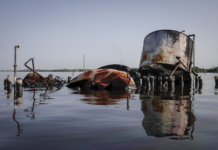[ad_1]
President-elect Donald Trump announced in a video posted to YouTube November 21 that he planned to roll back some Obama administration regulations on the energy sector on his first day in office.
«On energy, I will cancel job-killing restrictions on the production of American energy — including shale energy and clean coal — creating many millions of high-paying jobs,» Trump said. He also announced a plan to undo two regulations for every new regulation issued.
While Trump offered no specifics on the «restrictions» on his chopping block, analysts believe the incoming administration will likely target Department of Interior and Environmental Protection Agency regulations on methane emissions from oil and gas operations, hydraulic fracturing and possibly a new plan for drilling in federal waters.
«I think [Trump will] be able to do a lot, hopefully, and return that kind of oversight to states where it belongs,» Congressman Kevin Cramer, a North Dakota Republican and top Trump energy advisor, told S&P Global Platts in a recent interview. «Some of that he can do, maybe, by simply eliminating certain rules or regulations or taking them back from the courts where they’re in limbo.»
Article continues below…
To add to the pressure, House Republicans have warned the Obama administration against rushing through controversial regulations and have threatened to use Congressional Review Act resolutions to nix major rules that are finalized at the end of Obama’s term. Given that CRA procedures count back 60 legislative days, such actions potentially imperil a host of rules completed in recent months.
One contested regulation, finalized by Interior’s Bureau of Land Management on November 15, is aimed at curbing venting, flaring and leaking from oil and natural gas operations on federal lands. While the rule will become effective before Trump takes over the White House, the Independent Petroleum Association of America and the Western Energy Alliance, both industry groups, and at least two states, Wyoming and Montana, have filed lawsuits in federal court seeking to overturn it.
Analysts said it was unlikely that the Trump administration would fight to uphold a rule in federal court it also wanted to overturn.
It’s unlikely that the incoming administration would continue to fight an appeal of a federal judge’s ruling in June which overturned BLM’s rule that would have established new requirements for fracking on federal lands. The Obama administration has appealed that ruling in the 10th Circuit Court, but opening arguments are scheduled for January 17, just three days before Trump’s inauguration.
Similarly, 15 states, including Texas and North Dakota, and industry groups sued the EPA in August arguing that the agency’s methane emissions rule was unnecessary and costly for the oil and gas industry. The rule, which was finalized in May, sets new limits on methane emissions for new oil and gas infrastructure and is part of an Obama pledge to reduce US oil and gas methane emissions by 40% to 45% below 2012 levels by the year 2025. Arguments in these lawsuits have yet to be set with the courts.
Next step on methane could be sidelined
One effort seen as highly vulnerable is EPA’s next step in methane regulation. EPA sent out a request to industry for information, which was expected to be used in developing regulations limiting methane emissions from existing oil and gas rigs and wells. But that rule is unlikely to be proposed before Obama leaves office and is expected be cast aside by EPA under Trump.
Trump could also ease EPA’s efforts to reshape the Renewable Fuel Standard. Earlier this month, EPA said it planned to deny applications from refiners and their trade groups seeking to move the RFS’ point of obligations away from refiners and importers to further downstream.
Instead of denying the applications outright, however, the agency opened their proposed denial to a public comment period which will not conclude until after Obama leaves office, leaving the final decision up to the Trump administration.
In addition, the Trump administration may attempt to scrap the 2017-22 plan for US offshore oil and natural gas lease sales, which the Obama administration finalized last week. That plan allows 10 sales in the Gulf of Mexico and one for Alaska’s Cook Inlet, but removed originally proposed sales in US Arctic waters. The Trump administration could redo the plan to include sales in Arctic and other US waters, but the legal process to do so may last as long as three years.
Another obvious target by the next administration is the Clean Power Plan, which is overwhelmingly expected by industry and Washington observers to be overturned. The only question among those observers is the mechanism by which the Trump administration will be able to achieve this.
Debate centers around whether the rule will be struck down by the DC Circuit Court of Appeals, when it acts late this year or early next, or whether EPA would need to go through a long and more complex rulemaking process to reverse the policy.
An easier target is the White House Council on Environmental Quality’s guidance for how agencies should consider greenhouse gas emissions as part of National Environmental Policy Act reviews. Because it is not a regulation, the guidance is considered straightforward to undo. It is closely watched by pipeline developers because litigation over projects has often focused on the scope of climate change calculations.
Pending pipeline safety rules, while facing pushback from industry, are less likely to be reversed given that they are needed to fulfill statutory mandates, although continued pressure over their outlines is expected. The IPAA said the Pipeline and Hazardous Materials Safety Administration’s major gas transmission safety rule is among its priorities, given that it would change the definition of gathering lines so that pipelines near the wellhead would fall under federal jurisdiction.
‘Midnight’ rules become targets on the Hill
Attention in Washington has turned over the last week to the flurry of regulations, proposals and policies the Obama administration is pushing out the door before the change in administrations.
House Republicans have pressed the administration not to act on controversial regulations in its waning days and have raised the prospect of using the Congressional Review Act at the start of next administration, when Obama is no longer there to veto such efforts.
The act allows Congress to quickly vote to shelve major rules finalized within 60 legislative days of the end of the session. While it’s not yet clear if the new Congress would follow through on that threat, it could potentially take up a series of CRA resolutions to undo contested rules.
One rule that could become ensnared in such efforts is the Commodity Futures Trading Commission’s pending regulation on position limits, which CFTC Chairman Timothy Massad has been seeking to finalize by the end of the year. Massad last week said the regulation is now pending before his fellow commissioners.
He has already received a letter from House Agriculture Chairman Michael Conaway, Republican-Texas, warning against him moving ahead. Failing to leave controversial rulemakings to Massad’s successor could add to compliance burdens and sow confusion for end-users, Conaway said.
Also potentially making the cut in terms of timing is EPA’s final rule for new and modified sources of methane emissions in the oil and gas sector, published in the Federal Registerin early June.
No doubt there are longer lists of rules and proposals circulating in Washington given the signals sent by the new administration.
The IPAA identified dozens of regulations it believes threaten the oil and gas industry. But rolling back the rules is a fairly complex matter, said Jeff Eshelman, a spokesman for the group.
«It would be over-simplified to say that President-elect Trump could simply sign orders to stop these regulations,» Eshelman said. «[A] large portion of the current regulatory regime is in litigation and have many intervenors … so there would have to be a settlement that goes through the courts with all the parties involved.»
–Brian Scheid, brian.scheid@spglobal.com
–Maya Weber, maya.weber@spglobal.com
[ad_2]
Fuente








